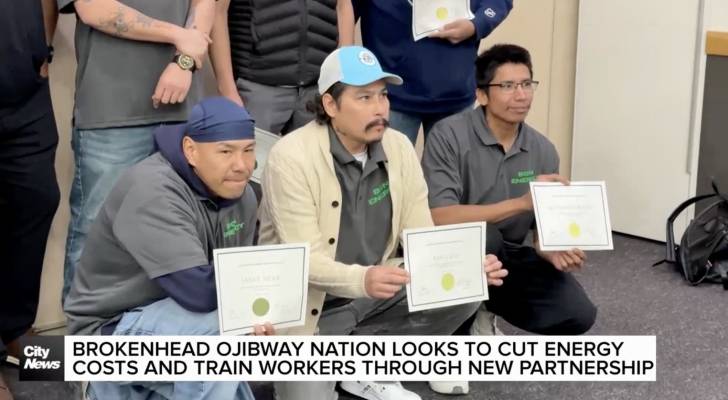
Brokenhead Ojibway Nation (BON), located northeast of Winnipeg, is taking a major step toward energy independence and long-term cost savings by installing 100 ground-source heat pumps in community homes. The $8.89 million initiative, launched in partnership with Efficiency Manitoba and Raven Indigenous Outcomes, aims to reduce heating bills, improve home comfort and train local residents in sustainable infrastructure.
The project is funded in part through Raven’s Outcomes Fund and will run through 2029, with plans to expand to other First Nations across Manitoba. According to CityNews Winnipeg, Chief Gordon Bluesky said, “What we are trying to do is not only look at the efficiency of the home but make these homes last as long as possible as well.”
In addition to lowering energy costs, the initiative focuses on building local capacity. BON member Colby Bruyere is one of the community members receiving training to install and maintain the systems. As he told CityNews, “Knowing I can heat houses within the community and do the maintenance myself, 3 a.m. in the morning you give me a call and I’ll be there.”
A model other communities are watching
Colleen Kuruluk, CEO of Efficiency Manitoba, emphasized the broader impact this kind of project could have. Speaking to CityNews, she said, “We are talking to First Nations all the time and I expect this announcement will create more interest with those partners we have.”
The heat pumps being installed are up to 400% more efficient than traditional heating methods, and Kuruluk added that the geothermal systems will improve indoor air quality and help reduce the strain on Manitoba Hydro’s energy infrastructure during the winter months.
This is not the first Indigenous-led energy efficiency project in Manitoba. Other First Nations, including Fisher River Cree Nation and Peguis First Nation, have already implemented geothermal and energy-efficient upgrades. BON’s project builds on that momentum and demonstrates how Indigenous communities are leading the way in sustainability, cost-efficiency and self-reliance.
What this means for personal finances and the future
For community members, the benefits are immediate: lower utility bills, reduced reliance on expensive and inconsistent heating fuels and increased housing comfort. Over time, the geothermal systems are expected to pay for themselves in energy savings, while also reducing the need for emergency repairs and energy subsidies.
Historically, many First Nations communities have faced high heating costs due to aging infrastructure and inefficient systems. BON’s investment signals a shift not only toward cleaner energy but toward long-term financial resilience and independence.
With training and employment for local residents built into the program, the benefits go beyond heating. This is about creating sustainable careers and keeping money circulating within the community. If successful, this could serve as a national example of how Indigenous-led, clean energy solutions can address economic, environmental and housing challenges all at once.
FAQs: What you should know about geothermal heating
What is a ground-source heat pump?
A ground-source heat pump (also called a geothermal heat pump) is a highly efficient system that uses the stable temperature underground to heat or cool a building. In winter, it draws heat from the ground; in summer, it pushes heat back into the earth.
How much can it save on energy bills?
Savings can vary based on location, home size and existing systems, but geothermal heating can reduce heating and cooling costs by up to 60% compared to conventional systems, according to Natural Resources Canada.
Is this only for First Nations?
Not at all. While Brokenhead Ojibway Nation is leading by example, similar funding and programs are available for individuals, municipalities and other Indigenous communities through:
- Canada Greener Homes Grant
- CMHC’s Indigenous Shelter and Transitional Housing Initiative
- Provincial programs like Efficiency Manitoba
Can I apply for help installing a system like this?
Yes. Many provincial and federal programs offer grants or low-interest loans for geothermal installations. Start by checking:
- Efficiency Manitoba
- Canada Greener Homes Initiative
- Your local utility company for rebate programs
What are the long-term benefits?
Beyond lower energy bills, geothermal systems are durable (lasting 25+ years), environmentally friendly and low-maintenance. They’re also a hedge against rising heating costs in the future.
Sources
1. CityNews: Manitoba First Nation enters partnership aimed at lowering community’s heating bills (May 8, 2025)
This article provides information only and should not be construed as advice. It is provided without warranty of any kind.